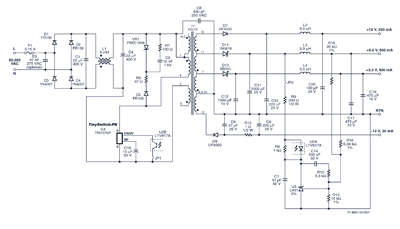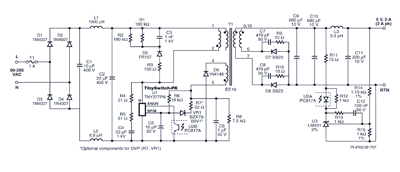Here’s help meeting the performance and regulatory needs for systems with peak-to-continuous power requirements
BY ANDREW SMITH
Power Integrations
San Jose, CA
http://www.powerint.com
Many of today’s popular consumer products see a high ratio of peak-to-continuous power demand. Stationary motors have very low impedance and draw higher current from the power supply as they turn. The load falls dramatically as motor speed increases. Equipment such as DVD players therefore need additional power to start the motor that opens the DVD drawer. Set top boxes need more power to spin-up their disk drive motor. Printers drive several printer motors simultaneously to drive paper feeds and move the print head. In each of these cases, the system must have access to higher peak power for short periods while maintaining a lower continuous load.
From the system designer’s perspective, a large gap between peak and continuous power requirements poses a major design challenge. While the system spends most of its time consuming relatively low amounts of power, all the system components, especially transformers, output diodes and bulk storage capacitors, must be designed to withstand peak operation. This requirement drives up system cost.
New power switching approaches are being developed that allow designers to address this problem, permitting power supply designs that can deliver peak power up to approximately 3 times continuous power capability for short periods without requiring an increase in the size of the Transformer and other switching components. By doubling operating frequency and boosting current limit for short periods, this new approach allows designers to deliver higher power levels for short durations with a small transformer and switching MOSFET. This reduces the size, weight, and cost of the end design.
DVD player power supply

Fig. 1. A universal-input multiple-output flyback power supply for a DVD player delivers 7.5 W continuous output power and 13 W of peak power.
A universal input, multiple-output flyback power supply (see Fig. 1 ) for a DVD player delivers 7.5 W continuous output power and 13 W of peak power. The key element in the design is the TNY376PN off-line switcher IC. This device form power Integrations combines a high voltage (700 V) power MOSFET with an on/off controller that integrates an oscillator, high-voltage switched current source, current limit, thermal shutdown and other protection circuitry into a single monolithic package. Internal start-up bias current is drawn from the drain pin that eliminates the need for external startup components. When presented with a peak load the IC automatically increases the current limit and switching frequency for the converter. This allows the use a smaller transformer and output filter than when following a traditional “peak-all-the time” design philosophy. The IC operates at up to 132 kHz under normal operating conditions; during peak load current limit is boosted by 30% and doubles the maximum switching frequency to 264 kHz.
Diodes D1, D2, D3, and D4 and capacitors C1 and C4 rectify and smooth the ac input. Capacitors C1, C2, and C8 and choke L1 provide differential and continuous mode EMI filtering. Output voltage is monitored via (U3) and U2 which cause a proportional current is drawn from EN/UV pin of the TNY376PN. The IC employs an on-off control scheme, enabling or disabling the switching cycles to maintain output regulation.. The on-off controller in the IC skips switching cycles when the EN/UV disable threshold of 90 µA is reached. When current out of the EN/UV pin drops, switching cycles are re-enabled. On-off control has the added benefit of reducing switching loss (compared to a fixed-frequency PWM scheme) and so offers good efficiency that is largely independent of load. To control output ripple, reduce audible noise and reduce group pulsing, the disable threshold is modulated ensuring evenly spaced current pulses.
This design, benefiting from the low loss switching approach inherent in on-off control is able to deliver 0.6 W to the output for 1 W input and offers a no-load power consumption of less than 150 mW at 230 Vac. It meets CEC/Energy Star 2008 requirements for active mode efficiency and complies with CISPR-22/EN55022B limits for conducted EMI.
Game controller power supply
A second power supply design example is illustrated in Fig. 2 . This schematic shows a universal input 5-V, 2-A (3-A peak) power supply for a portable game player. Similar to the DVD player power supply design mentioned above, this circuit uses a TinySwitch-PK, in this case TNY377PN.

Fig. 2. A universal-input 5-V 2-A (3-A peak) power supply for a portable game player also uses a TinySwitch-PK, in this case TNY377PN.
This power supply design also features an optional over-voltage protection (OVP) circuit. When there is overvoltage in the output, VR1 breaks down and via R7 and delivers increased current to the BP/M pin. When this current exceeds 7 mA, U1 latches off. The latch remains active until the BP/M voltage drops below 4.8-V following the removal of the input ac.
This power supply delivers 10 W continuously and 15 W peak. It also easily meets CEC/Energy Star 2008 requirements for average active mode efficiency (71%) achieving an average efficiency of greater than 74%. The supply meets CISPR-22/EN55022B limits for conducted EMI with a 10 dBµV margin. Also, no-load power consumption is less than 100 mW at 230 Vac.
Conclusion
Given the demand for higher levels of functionality and lower costs, it is likely that designers will see an increasing number of systems that require high peak-to-continuous ratio power requirements. The two examples described above will allow engineers to address these performance requirements with a small-size low-cost solution that will still meet stringent regulatory constraints by delivering high efficiency under all load conditions.
For more on power supplies, visit http://electronicproducts-com-develop.go-vip.net/power.asp.
Advertisement
Learn more about Power Integrations





